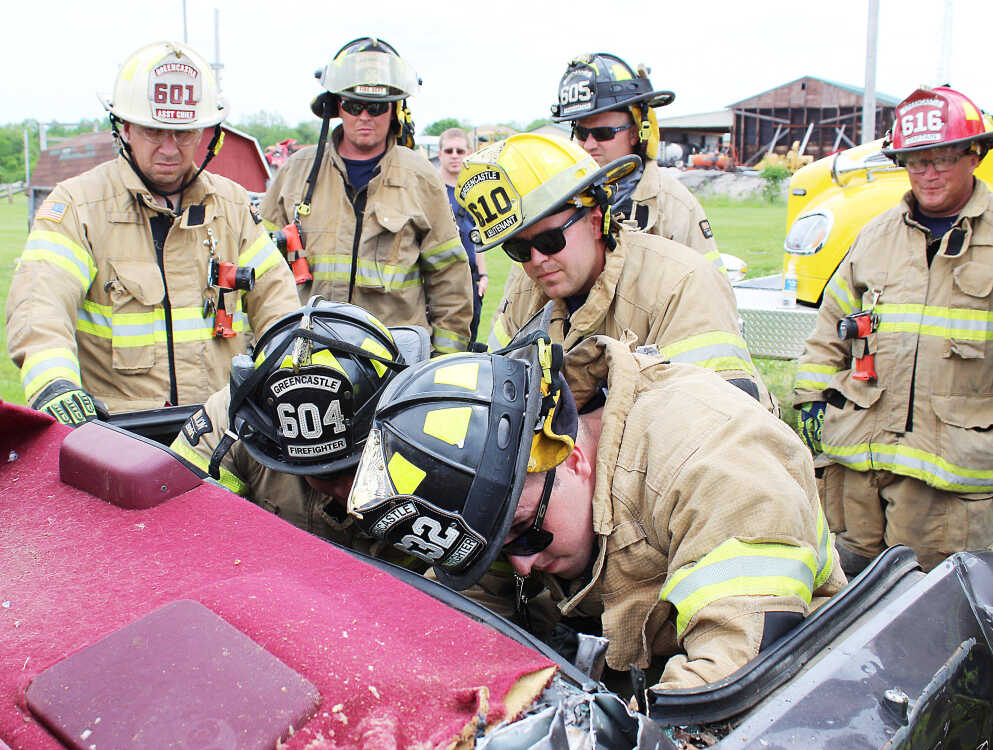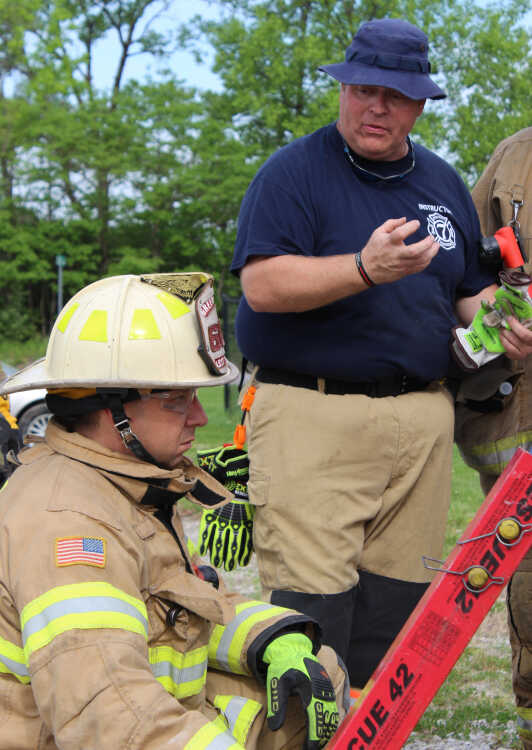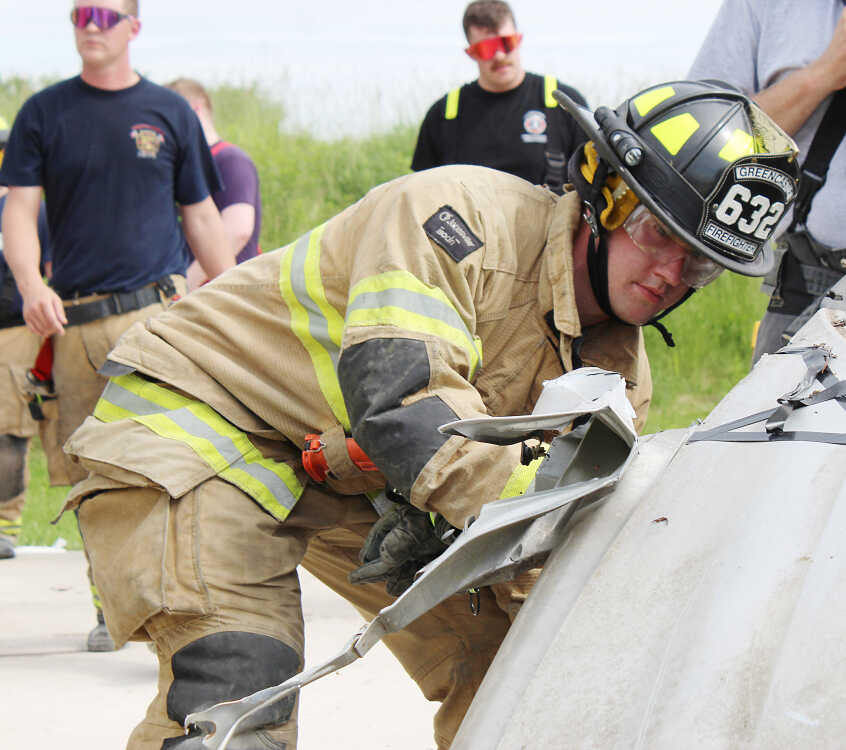Extrication training part of local firefighters’ ongoing education

Captain Kyle App has been with the Greencastle Fire Department for nearly the past two decades. Even with having all of this experience, though, learning how to be a more effective first responder never stops.
This was certainly the case last Saturday and Sunday as App was one of several firefighters from GFD and other local fire departments who got some hands-on experience to complete a Vehicle Rescue Operations (VRO) course.
With both classroom and practical training, the course teaches fire personnel how to work safely at incidents with people injured and/or entrapped in a wrecked vehicle. It emphasizes techniques and procedures to stabilize the vehicle and secure the scene, as well as protecting the patient during an extrication.
Firefighters went out to the fire training site southwest of Greencastle to practice those techniques. They were then tested on the practical skills and also took an online test.
Greencastle personnel who completed the course include Asst. Chief Rob Frank, Lts. Jason Simonson and Darrick Wiatt, Capts. App and Kenny Shepherd and firefighters Jake Armstrong, James Shaw, Brandon Watson, Jonny Newgent, Ben Wright, Tanner Wood and Grant Bryan.
Firefighters from the Cloverdale Township, Madison Township and Jefferson Township volunteer fire departments in Putnam County and the Van Buren Township Volunteer Fire Department over in Clay County also participated.
Greencastle Fire Capt. Brian Poole and Lt. Brock Beebe previously completed the VRO training. Meanwhile, Armstrong, Newgent and firefighter Peter Moorton have also been taking a Hazardous Materials Technician course in Terre Haute.
The training was led by District 7 Fire Training instructor Jon Shackelford, who is also the battalion chief and training officer for the Honey Creek Fire Department. He was backed up by Terre Haute Fire Capt. Doug Curry as lead evaluator and Brazil Fire Capt. Roy Keller as an assistant.

The training took place with temperatures hovering around 85 degrees Fahrenheit with all of the firefighters in their turnout gear. It was imperative for everyone to stay hydrated and know their limitations.
Shackelford explained the general procedure for a successful extrication, which starts with stabilizing a vehicle and disconnecting battery power. Once airbags and other components have been checked, dismantling the car piece by piece begins.
The goal of an extrication is to remove the vehicle from the patient, not the patient from the vehicle. This allows first responders better access to the patient and minimizes further injury. In this, though, there are many elements to consider before tackling an extrication.
“A lot of times, it’s dependent on the car wreck,” Shackelford said. “Where’s the vehicle broken? Where are the patients entrapped? Are their feet entrapped? Is the door folded over? Is the roof down? Is the dash down on them? It just depends on how the vehicle bends and how the vehicle’s involved in the wreck.”
Extrication has to be methodical and dynamic, because every accident will have different challenges. The condition of a vehicle prior to the accident will affect how it will bend. No matter what the circumstances, time becomes of the essence in each scenario.

“A lot of the time, the damage is done before we get there,” Shackelford said. “We’re trying to lessen that damage, and lessen the time until that victim is with a surgeon. That golden hour is what we’re trying to accomplish.”
That “golden hour” begins when a call is made to 911 and the dispatcher takes information. The dispatcher then alerts the fire department. The fire department gets on scene, makes assessments and performs the extrication as an ambulance is on the way.
Shackelford said an extrication can be completed in about 30 minutes. This is an efficient operation even as every second counts. It becomes crucial for firefighters to keep calm while and not let it get to them.
“If you have a car that’s really broken and it’s really hard to move, it’s really easy to get frustrated,” Shackelford said. “You have to have good firemen and good leaders who can step back and say, ‘Take a deep breath, let’s look at what this is doing.’
“On the fire and rescue side, we see people at their worst,” he added. “People call us when they’re having a very, very, very bad day. We’re there trying to make that day better, and that can be absolutely taxing. You’re so focused on (how) you gotta get this job finished.”
Extrication training helps ensure that firefighters are more proficient with their tools and the techniques, which then turns into speed and accuracy on the scene. An operation has to embody the concept of “Slow is smooth, smooth is fast.”
“If you’re not continuing to build these skills, you’re not gonna lose them, but you’re not gonna be sharp,” Shackelford said. Even with 13 years of extrication instruction with District 7 under his belt, there are still things he will pick up.
Last year, GFD responded to 48 accidents with and without injuries, with four involving a pedestrian and five which required extrication. In 2019, GFD went out to 71 accidents with and without injuries, with six involving a pedestrian. Three extrications were performed during this time.
At the end of the day, what makes a dynamic operation possible each and every time comes down to teamwork and clear communication. This means setting expectations despite the unpredictability of any given incident.
“Everybody knows their part and their place,” App said following the practical and written skills testing on Sunday. “Depending on the situation, I like another set of eyes behind me seeing what I don’t see. That’s basically what we’re doing. We’re watching out for each other as well as the job at hand.”
The training itself reinforces better working relationships among the firefighters. App emphasized that since it was done in a staged way, it was important to bounce ideas afterward about how to go about the procedures better.
“That’s why we always have to train and we always have to keep going and keep learning,” Watson said. “You gotta really be passionate about the job. Everybody wanted to do it. Everybody wanted to have their chance at doing the job.”

